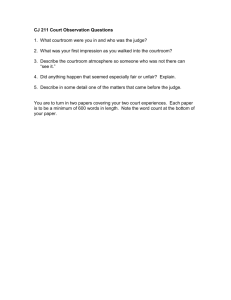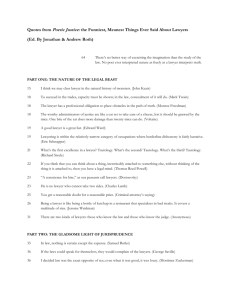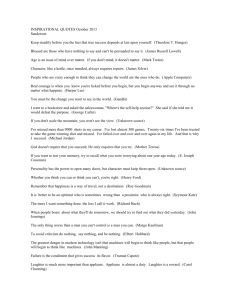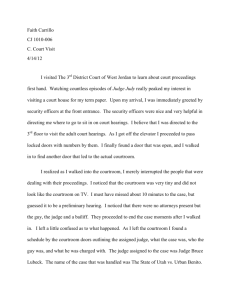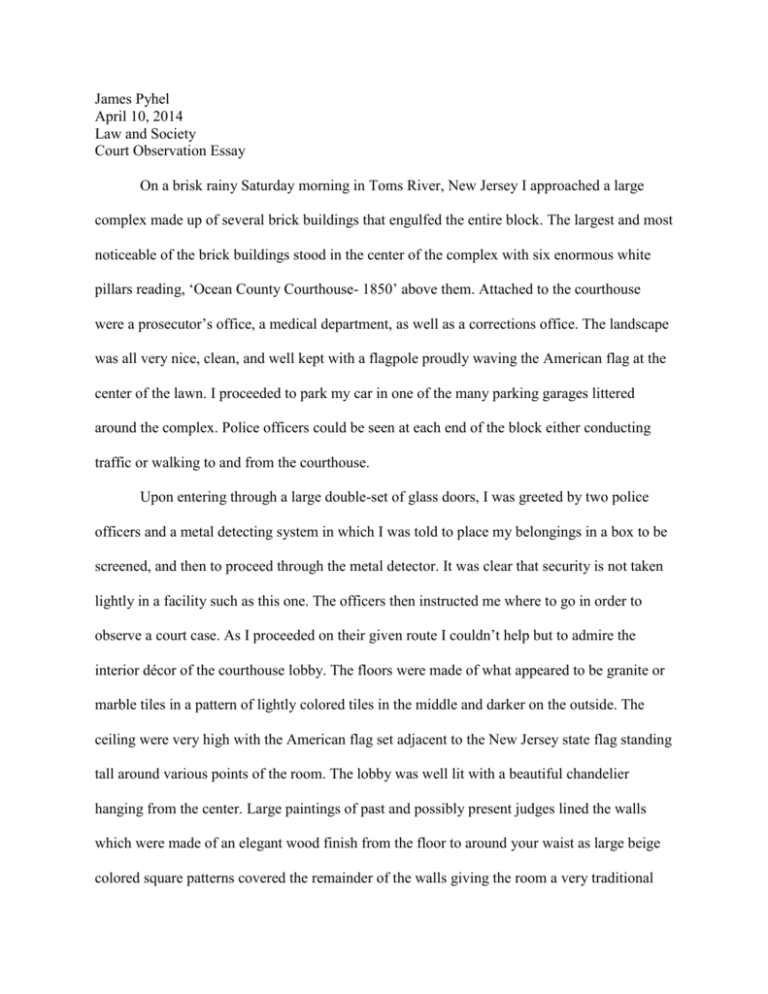
James Pyhel
April 10, 2014
Law and Society
Court Observation Essay
On a brisk rainy Saturday morning in Toms River, New Jersey I approached a large
complex made up of several brick buildings that engulfed the entire block. The largest and most
noticeable of the brick buildings stood in the center of the complex with six enormous white
pillars reading, ‘Ocean County Courthouse- 1850’ above them. Attached to the courthouse
were a prosecutor’s office, a medical department, as well as a corrections office. The landscape
was all very nice, clean, and well kept with a flagpole proudly waving the American flag at the
center of the lawn. I proceeded to park my car in one of the many parking garages littered
around the complex. Police officers could be seen at each end of the block either conducting
traffic or walking to and from the courthouse.
Upon entering through a large double-set of glass doors, I was greeted by two police
officers and a metal detecting system in which I was told to place my belongings in a box to be
screened, and then to proceed through the metal detector. It was clear that security is not taken
lightly in a facility such as this one. The officers then instructed me where to go in order to
observe a court case. As I proceeded on their given route I couldn’t help but to admire the
interior décor of the courthouse lobby. The floors were made of what appeared to be granite or
marble tiles in a pattern of lightly colored tiles in the middle and darker on the outside. The
ceiling were very high with the American flag set adjacent to the New Jersey state flag standing
tall around various points of the room. The lobby was well lit with a beautiful chandelier
hanging from the center. Large paintings of past and possibly present judges lined the walls
which were made of an elegant wood finish from the floor to around your waist as large beige
colored square patterns covered the remainder of the walls giving the room a very traditional
look. I continued through the lobby down a hallway en route to ‘courtroom 008’ as instructed
by the police officers who checked me in. The wide hallway was lined with the entrances to
each courtroom protected by large, wooden, closed double doors about 30 feet apart from each
other. The other side of the hallway was lined with a series of very long wooden benches where
people sat as they waited for permission to enter the courtroom.
As I stood and waited with a small group of people who all appeared to be lawyers I
noticed that they were each conversing with one another, introducing each other and discussing
their cases almost in a discrete way. As I eavesdropped some more I could tell that some were
even gossiping about others that they worked with. An awkward silence among the group of
lawyers gave me an opportunity to introduce myself and state what I was doing sitting amongst
them. I told the group of lawyers that I was here to observe a court case as an assignment for a
class. The group’s response was welcoming and understanding however there was one lawyer I
had been sitting next to that was particularly intrigued by my presence among them. As we
talked some more I learned that I was about to observe motion hearings at the Superior Court
level in the civil law division. He then went on to explaining to me that today was a special
motion day and that every other Saturday in New Jersey is a designated motion-hearing day.
Apparently a motion hearing is relatively brief and not as exciting as the actual trial, which
explained to me why I was the only observer awaiting the cases. As I sat with the lawyers I
learned that my new acquaintance was waiting for the other party’s lawyer to arrive. In an
irritated tone, he told me that if I ever become a lawyer, don’t ever be late! Shortly after these
words of wisdom, a woman opened the doors and invited us into the courtroom.
A rather modern looking courtroom with security cameras in almost every corner of the
rectangle shaped room. Another American flag accompanied by a New Jersey state flag stood
in the corner near the judge’s desk. The walls were made of a dark wood, as well as the
benches in which I sat. There was also a gate that divided where I sat to the plaintiff and
defendant stand. In the front of the room was the Judge’s desk, which was raised higher than
any other. On the desk was a nameplate reading, ‘Judge Mark A. Troncone’. On his left sat a
young white woman who was the law clerk that was probably either a law student or a recent
graduate of law school. To the judge’s right was another desk where an older woman who was
the court clerk. She sat and recorded/assisted the judge throughout the proceedings. There was
also a jury box on the side of the plaintiff however there was nobody sitting in it. The actual
plaintiff and defendant for each case were not present. The law clerk went to each lawyer and
asked their names as well as whom they were representing for which case. Being the only
observer in the room, she even asked me what party I was representing. As I hesitated to
answer her contemplating if I could feasibly get away with posing as a lawyer for the day and
allow me to write a far more epic court observation paper, I remembered the intense security I
had to go through upon entry and the mammoth amount of trouble I could get into for
impersonating a lawyer. I replied to her, “No, I am just here to observe”.
As I was instructed to rise for the honorable Judge Troncone, he then arrived through a
door just behind his desk and sat. He was an older gentleman with a soothing voice, thick head
of grey hair, and glasses. One of the lawyers stood behind the defendant’s podium and another
stood behind the plaintiff’s podium. Two more lawyers sat with me in the observation section
awaiting their hearing. As the first hearing began, I noticed that each lawyer was extremely
polite and respectful to the judge. When the lawyers were first called upon by the judge they
each asked how the judge’s day was going and referred to him as, ‘your honor’ throughout the
hearing. The first case did not discuss the particular facts of the case due to it being a motion
hearing. From what I understood, this case was in regards to a car accident in which there was a
dispute between the person in the accident, and the insurance company. The lawyer
representing the plaintiff was trying to file a motion claiming the insurance company’s
requirements. The defending lawyer representing the insurance company repeatedly used
acronyms that I could not interpret to explain how the motion the plaintiff was trying to file
was invalid for the case. I was surprised at some of the abbreviations that both the lawyers and
judge were using and how each person knew exactly what they were talking about. At times
this first hearing moved very quickly and was difficult to follow along and interpret, as I had no
prior knowledge to the facts of the case, which were not discussed in the hearing. After asking
the lawyers to clarify on specific facts and issues of the case and gaining a thorough
understanding of what each party was arguing, he dismissed the lawyers without giving a ruling
on weather or not the plaintiff’s motion would be used in the trial. He stated that he would fax
his decision to each party later that day.
The second motion hearing I managed to make more sense of as it moved slightly
slower. It began with the same ritual, as did the first motion where each party stated their name
and continued to talk in an extremely polite and respectful way to the judge. This time, there
were two lawyers representing the defendant and one lawyer representing the plaintiff. When
the lawyers where asked to state their names and who they were representing, from the
defending side, one lawyer was representing herself, and the other lawyer was representing the
law firm. The reason there were two defense lawyers was because the plaintiff was suing her
former company, as well as her former boss that fired her. The woman that was fired worked
for a law firm and claimed that she was fired because of discrimination. She is also suing her
boss (who is a lawyer at the law firm) because she believes that her boss who is also a female
had sexually harassed her. The lawyer representing the plaintiff was arguing to file for a motion
for Law Against Discrimination claims as well as Common Law claims. The defense was
arguing that the plaintiff’s Common Law claims could not be used during the trial if she was
also suing for Law Against Discrimination claims. One of the defense lawyers even stated, “A
motion to dismiss counts of the complaint pursuant to New Jersey Court Rule 416-2CE”. After
reviewing this rule my interpretation of what the defense lawyer was trying to argue was that a
motion to dismiss under Rule 416-2CE is to dismiss the claims on the complaints as a matter of
law. As a matter of law, there is no set of facts where plaintiff’s claims could get to a jury. I
heard both the defense and the plaintiff explain Rule 416-2CE to the judge and then their
individual interpretation of it. The judge clearly controlled the conversation and maintained
authority as well as a powerful presence throughout the entirety of the hearings. Like the
previous motion hearing, the judge did not decide weather any particular motion would be
submitted or denied into the actual case stating that he would fax his answer later in the day.
My trip to the Ocean County Courthouse was an informative one as it was the first time
I have ever witnessed the formal proceedings of a court case. There were all types of people in
terms of race, gender, ethnicity, and social status in and around the courthouse each there for
their own personal reasons. Most of these people were dressed in formal attire and some were
dressed in their normal street clothes. I found it interesting to see how lawyers interacted with
each other as well as the judge. I was also intrigued by getting a first hand experience of how
the law is dealt with and enforced in a formal way exciting my experience at the courthouse to
put more consideration into my future in terms of a career path.
Observing the Ocean County Courthouse and the motion hearings that ensued inside of
it taught me a lot about the ways in which our justice system functions. It is easy to relate much
of which I learned during my visit to what I have learned in class through the lectures and
assigned readings. Jumping to mind from when I first decided to observe the Ocean County
Courthouse was the question of where the particular courtroom would fit in the broader scheme
of the American Judicial system. I learned that I had attended Superior Court in the civil
division, which has general jurisdiction. This means that this courtroom handles a great variety
of different cases as opposed to a court of limited jurisdiction that would handle a specialized
sort of case or problem. Due to the absence of a jury I could tell that it was a trial court where
the judge hears the evidence and then decides the matter of fact and law. This was especially
evident in the second motion hearing when the two lawyers were going back and forth at each
other with their own interpretations of the specific rule. The Judge listened to each
interpretation and then applied his knowledge to determine if either was correct. I found it
interesting to see how the judge decides and applies the law by asking the lawyers to explain
their positions, then providing a critique or compliment to them on their grasp of the law.
In the textbook, “Courts and Judicial Policymaking” by Christopher P. Banks and David
M. O’Brien, the civil trial process is discussed stating; “The range of civil litigation is
demonstrated by its growing impact as a tool to impose economic liability” (260). This relates
to both motion hearings because in both cases there was a plaintiff suing in effort to receive
monetary compensation from the opposing party. However, I think that the most important
aspect that Banks and O’Brien explain in relation to my court observation is the common law
system itself that we have in America. The first chapter of the textbook highlights how the
common law legal system is an adversarial system that gives power to the judge, prosecutor,
and most importantly the citizen. The judge acts as an umpire regulating the case to ensure it is
done properly and fairly. Banks and O’Brien describe the role of the judge stating, “The judge
is the central figure in a common law system” (9). This was evident in both cases I observed as
the judge would hear the different motions and claims both parties would make and use his
discretion to determine facts. The common law system gives the citizen the right to have a
defending attorney who will try to argue his/her clients case to the best of their ability. I found
it interesting in the second motion hearing that the defendant was actually representing herself
in trial. Granted she is a lawyer, I found it interesting that she would choose to represent herself
in a case where she was being accused of sexually harassing a colleague. The law firm that was
being sued for discrimination had a separate law firm representing them in the case, which I
speculated was due to insurance coverage they may have had.
One of the complexities in the common law system Banks and O’Brien discuss is the
fact that the judge is impartial and cannot obtain any evidence himself. They state, “Lawyers
have more control and influence in common law systems, and judges ostensibly let attorneys
fight it out” (11). This was evident in the cases I saw as the lawyers from each side were
essentially arguing over their interpretations of rules of the law. It was interesting to see how
much discretion the judge is required to use as both parties would make persuading arguments.
This also relates to Banks and O’Brien’s description of the common law system as they say,
“Judges may embrace or reject the advocate’s arguments on the basis of the specific facts in a
case, thereby reserving the power to make law through the exercise of discretion” (11). Another
complexity I noticed in my observation that Banks and O’Brien claim is that common law
systems are often very time consuming. I realized this in the motion hearing because as I sat
and spent the good half of my day at the courthouse it made me think about how each of these
cases are only in the early stages and still have many more steps to take until a verdict is
reached. This was apparent as the judge couldn’t even give a ruling as to if the motions would
be passed or removed from the case stating at the end of each case that he would, “fax his
answer to each party later today”. As the judge would end the cases in this rather nonchalant
manner, it perpetuated a sense of authority and control in the way that he had an attitude of
ownership. Often times during the hearing the judge would subtly mock and undermine the
lawyers if they made a mistake in an interpretation or simply did not provide a thorough
argument in his responsive correction. However, the greatest sense of authority I received from
the judge was the clearly taller bench in which he sat overlooking the entire room. This goes
back to Banks and O’Brien in the sense that in a common law system, the judge is the central
figure. There was also a sense of legitimacy extended during the proceedings through the
language that was used between the lawyers and the judge. As I stated previously, I had a lot of
trouble following along with the first motion hearing mainly in part to the language used. There
were a lot of acronyms used by both the lawyers and the judge that I could not interpret or
decipher yet both parties clearly had prior knowledge of what all of those terms meant.
There is undoubtedly a sense of legitimacy and authority in the courtroom due to the
perception of the judge as well along with the sophisticated language used in the proceedings.
In the textbook, “The Common Place of Law” by Patricia Ewick and Susan S. Silbey, this
sense of legitimacy and authority can be expanded in an understanding of the law as a formal
institution. “We suggest that legality’s appearance of externality, coherence, majesty, and
timelessness is achieved by greater degrees of formal organization,” and furthermore, “the
formal institutional apparatus of law is synonymous with law,” (77). Ewick and Silbey are
implying in this quote that it is the formal institutions that give us our perception of the law.
This relates to my trip to the courthouse because I reflect on my experience and initial
impressions of the layout and décor of the complex. Upon entering you can feel that sense of
timelessness, majesty, and coherence the courtroom holds and it caused me to feel like I had
discovered a whole new world. What I mean by this is that people generally know what the law
is and know that they will end up in a courthouse by offending it, yet it is not something often
pondered in everyday life. Ewick and Silbey highlight this in stating, “Apprehending the law as
having an ontology and authority that is severed from the multiple concrete social practices and
relationships that enact it, the law confronts us as existing outside of everyday life. Despite its
constitution and enactment in particular social exchanges, legality confronts people as external,
unified, and objective…the law is rendered inert rather than dynamic, a place rather than a
system of ideas of persons,” (75). This shows how the law is external and viewed by people as
a system however, my visit to the courthouse allowed me to see the law in a way I had never
before giving me a new perspective. I was inside the system and was able to witness its
functions. Ewick and Silbey are making the argument that law’s legitimacy is gained through
the formal institutions where it is enforced. Since the average person does not visit the
courthouse on a regular basis, law is something that exists outside everyday life. However,
Ewick and Silbey make a note of how it still affects us routinely by saying, “Although the law
may appear remote from our taken-for-granted world, it also has a commonplace materiality
pervading the here and now of our social landscape. The material forms of the law include such
things as courthouses; parking meters; marriage, birth, death, and mortgage certificates” (16).
Ewick and Silbey make an example of how even though the law pervades our everyday life; we
are still forced to deal with it on a daily basis. There argument is convinces me because I reflect
on my own life and on a daily basis, I definitely do not think about the law very often but am
forced to deal with it. This is the perspective of a person whose greatest involvement with the
law comes from certain classes. In my visit to the courthouse I realized that people like
lawyers, police, judges, paralegals, etc. surely have a separate view of the law as they are
forced to directly deal with it and think about it every day.
Reflecting on my experience at Ocean County Courthouse I think of all the different
types of people I saw in terms of race, gender, ethnicity and social status. This made me think
about Michelle Alexander’s claims in the book, “The New Jim Crow” which highlights the
issue of race and the war on drugs in America. Alexander argues that there is a mass
incarceration of blacks in America. Throughout her book she lists various arguments
supporting this notion and although I do find many of them persuading, I did not see any
evidence supporting her claims during my visit to the courthouse. Although I did see many
different people around the courthouse, the cases I observed did not have the plaintiff or
defendant present at the hearing with the exception of the woman representing herself in the
second case.
In conclusion, I am satisfied with my visit to the Ocean County Courthouse in Toms
River, New Jersey. As previously argued, there were many connections between my
observation and the assigned readings. Now that I have been to a courthouse and have
witnessed the formal proceedings, I have a significantly better understanding of not only the
ways in which law is enforced and applied, but a better understanding of the law itself. Legal
institutions are what keep the country running safely through the methods of deterrence,
retribution, and rehabilitation. I am grateful for my experience observing the courthouse and
the trials that took place in it.
Bibliography:
Banks, Christopher P., and David M. O'Brien. Courts and Judicial Policymaking. Upper
Saddle River, NJ: Pearson/Prentice Hall, 2008. Print.
Ewick, Patricia, and Susan S. Silbey. The Common Place of Law: Stories from
Life. Chicago: University of Chicago, 1998. Print.
Alexander, Michelle. The New Jim Crow: Mass Incarceration in the Age of
Colorblindness. New York: New, 2010. Print.
Everyday

